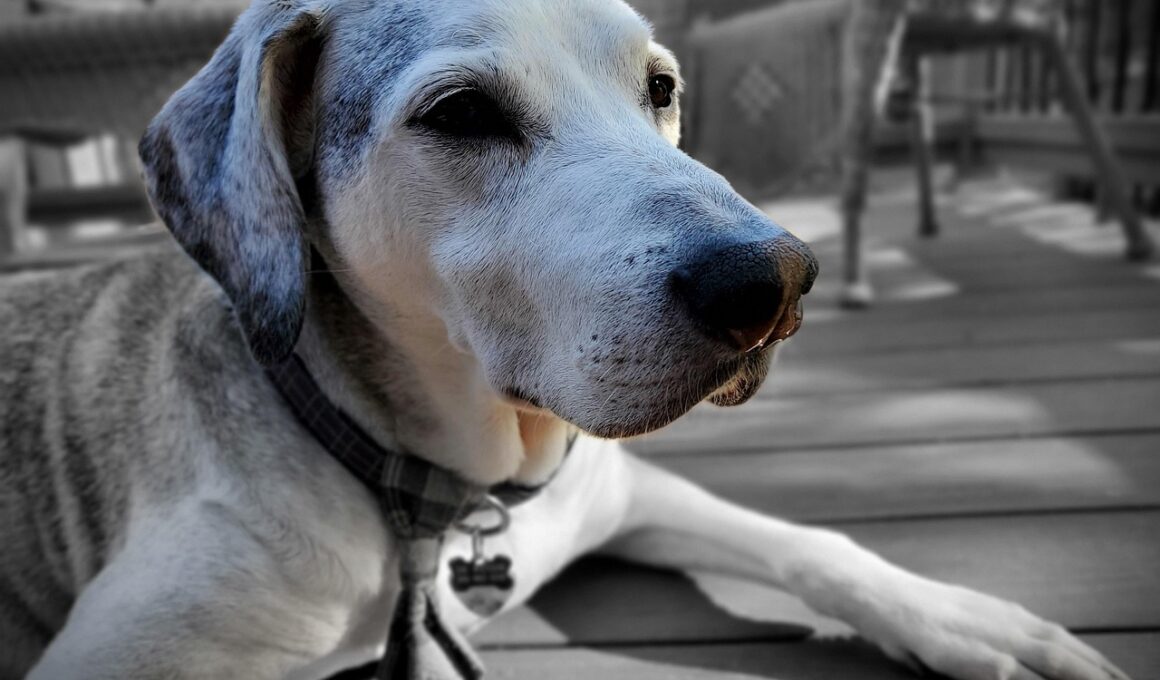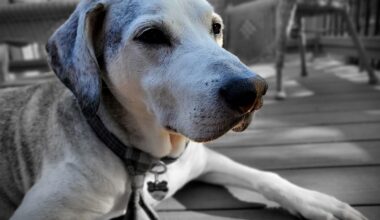Understanding REM Sleep in Senior Dogs
As dogs age, their sleep patterns undergo significant changes. One notable aspect is the increase in time spent in REM (Rapid Eye Movement) sleep, essential for their health. REM sleep allows dogs to dream, process experiences, and consolidate memories, much like humans. During this phase, the brain is highly active, and dogs often exhibit twitching, paddling, or vocalizations. These actions indicate they are engaged in dream activity, which is crucial for their mental well-being. For senior dogs, observing their sleep is essential to ensure they are getting quality rest. Many factors, such as environment, health, and stress, can impact their ability to enter or maintain REM sleep. Owners should create a safe, comfortable space conducive to relaxation, enabling their aging pets to sleep better. Regular routines, quiet spaces, and supportive bedding can enhance their sleep quality. Also, it’s advisable to consult a veterinarian if changes in sleep patterns are observed, as they could signal underlying health issues that require attention. Being mindful of a senior dog’s sleep needs fosters a healthier, more vibrant life in their later years.
One of the key considerations is the duration of REM sleep in senior dogs. Typically, dogs experience several sleep cycles throughout the night. In senior dogs, these cycles can be shorter, which means they may wake up more frequently. While younger dogs might average around 10-20% of their sleep in REM, older dogs may demonstrate variations. Studies show that senior dogs sometimes need help achieving deep REM sleep, impacting their overall health and mood. Owners should be attentive to these changes and monitor how often their dogs wake during the night. It is also valuable to recognize that age-related changes in sleep architecture can include alterations in deep sleep versus REM. By understanding these nuances, owners can better advocate for their dog’s needs. It is essential to observe any accompanying symptoms such as excessive daytime sleeping or lethargy, which may indicate obstructed sleep patterns. Creating a calming pre-sleep routine may assist in achieving more restful nights for older dogs. The goal is to optimize their sleep quality, thereby improving their emotional and physical health.
Factors Affecting REM Sleep
There are several factors that can significantly influence REM sleep in senior dogs. Health conditions such as arthritis, anxiety, or cognitive dysfunction can disrupt their sleep cycles, resulting in a less restorative experience. Pain management becomes crucial when dealing with discomfort in older dogs, stressing the need for guided veterinary care. Allergies or respiratory issues can also interfere with sleep quality, making it essential to maintain a healthy living environment. Stress and anxiety are commonly overlooked yet powerful disruptors of sleep. They can arise from changes in the household or even loud noises. Therefore, providing a quiet and peaceful environment is fundamental for aiding their comfort. Additionally, exercise plays a vital role in promoting quality sleep in senior dogs. Daily low-impact activities, like short walks or gentle play, can help tire them out, encouraging a more profound sleep experience. Owners should strive to create a routine that includes physical activity alongside mental enrichment, which is beneficial for an aging dog’s cognitive function and can improve sleep quality.
Nutrition is another significant factor that can enhance or hinder sleep quality in senior dogs. A well-balanced diet tailored to their specific age-related needs is crucial. Feeding senior dog food containing the right nutrients and avoiding heavy meals before bedtime can help promote better sleep. Limiting treats and ensuring a healthy weight can also reduce sleep disruptions caused by discomfort. Various supplements, such as omega fatty acids, glucosamine, and melatonin, can improve sleep duration and quality. However, always consult a veterinarian before introducing new supplements to their routine. Moreover, hydration plays an essential role in a senior dog’s health and can impact their sleep. Adequate access to fresh water is vital for maintaining energy levels and preventing discomfort. Another aspect is the sleeping area itself. It should be clean, comfortable, and free from distractions. Soft bedding can provide the necessary support for aging joints, especially for dogs suffering from arthritis. Ultimately, addressing diet, hydration, and bedding will contribute significantly towards maximizing a senior dog’s sleep quality.
Establishing Good Sleep Habits
Establishing good sleep habits is key to promoting REM sleep in senior dogs. Creating a consistent nighttime routine can signal to your dog that it’s time to wind down. Consider activities like a gentle massage or quiet time together to help them relax before bed. Dim the lights in the room and minimize noise. Dogs, like humans, benefit from a routine that cues them into their sleep cycle. Setting up a specific place where your dog feels safe can enhance their comfort. Creating this safe haven could lead to increased awareness of their sleeping needs. Consistency is critical; try to maintain the same bedtime each night. Alongside this, observe their behaviors leading up to sleep time and adapt accordingly. You may discover what conditions best help them fall asleep and stay asleep. Additionally, reducing stimulants, such as play or excitement before bed, can help promote deeper sleep. As dog owners, being proactive in setting these habits can contribute to overall better sleep outcomes over time, ultimately leading to a happier and healthier senior dog. Each small change can accumulate to make a significant difference.
It is vital to regularly assess behavioral changes and sleep habits over time. Keeping a journal of your dog’s sleeping patterns can help identify any trends or issues that may arise. Recognizing the signs of sleep disturbances or disruptions empowers you to act. If a dog’s sleep seems excessively disturbed, it is worthwhile to consult a veterinarian. Any changes in their sleeping behavior could potentially indicate health concerns that require intervention. Attention to these details can enhance the quality of life for senior dogs, ensuring they live their golden years comfortably. Observing general health and vitality is equally important when examining sleep patterns. If an older dog starts to experience changes like increased anxiety, excessive barking during sleep, or inability to settle down at night, it can warrant further investigation. Health assessments with professionals can provide insight into existing conditions affecting sleep. As responsible pet owners, prioritizing a senior dog’s comfort, well-being, and healthy sleep hygiene practices is essential. Working alongside veterinarians and pet care specialists can also offer valuable guidance tailored to your specific pet’s needs.
Conclusion
Understanding the intricacies of REM sleep in senior dogs is paramount for ensuring their overall health and vitality. As aging can lead to various changes in sleeping patterns, implementing strategies that promote restful sleep is essential. Paying attention to environmental factors, health conditions, nutrition, exercise, and daily routines plays a crucial role in facilitating sound sleep. Maintaining a watchful eye on your dog’s sleep behaviors allows owners to make proactive adjustments to enhance their quality of life. Additionally, fostering good sleep habits can lead to significant improvements in their well-being and mood. Future research will likely uncover further insights into how aging affects canine sleep. Until then, the responsibility lies with owners to create a conducive sleeping atmosphere. By prioritizing their needs, you significantly contribute to their happiness and comfortable living during their senior years. Through compassionate and attentive care, you can help your senior dog enjoy restful, rejuvenating sleep, ensuring they age gracefully and happily. In this way, both dogs and their owners can share many more cherished moments together.


